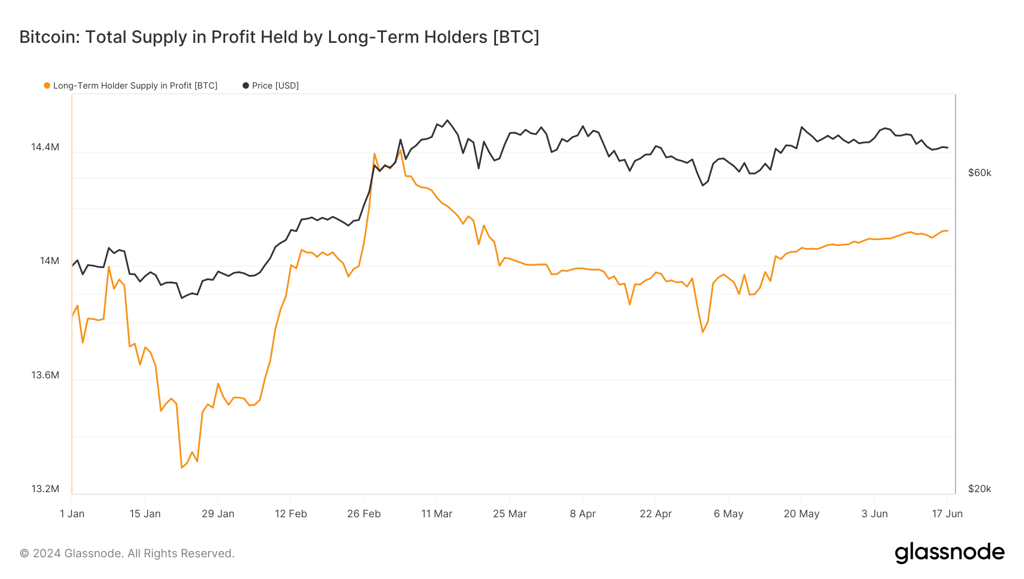The Crypto Market - Evolution in 2024
Rishabh Nagar
6/28/20248 min read
TL;DR
In 2024, the cryptocurrency market surged, fueled by Bitcoin and Ethereum ETFs, Bitcoin halving, and strong institutional investments. Key sectors like AI-related cryptocurrencies and DePIN showed remarkable growth, with DeFi TVL increasing by 84%. The market's evolution underscores growing maturity and confidence, signaling a robust future for digital assets.
As of June 21, 2024, YTD
Bitcoin (BTC) is up 52%,
Ethereum (ETH) is up 59%
Solana (SOL) is up 43%
Alt-coins are up 32%
Sector Performance: Artificial Intelligence (AI), Decentralized Physical Infrastructure (DePIN) and real-world assets (RWA) have shown the most strength.
AI-related cryptocurrencies: +414.7%
DePIN: +260.9%
RWA: +215.3%
For more on DePIN, see the Blue Rabbit Learn section below.
DeFi Advancements: Total Value Locked (TVL) in DeFi has surged by 84% year-to-date, reaching US$101.5 billion.
Yield Market Growth: The yield market within DeFi has grown by 184% this year, reaching US$10.64 billion in TVL, driven by the tokenization of real-world assets and liquid restaking.
Introduction
The Big Macro Picture
Since January, the cryptocurrency market has witnessed a remarkable upward, marked by notable gains in major digital assets. While pinpointing a single cause for this rise is challenging, a convergence of pivotal events offers insights into the underlying factors. The approval of multiple Bitcoin ETFs has significantly boosted institutional and retail investor interest, providing an accessible pathway to crypto investments. Simultaneously, the anticipation and subsequent approval of a spot Ethereum ETF has driven substantial buying activity, further bolstering market sentiment. The Bitcoin halving event, historically known to trigger price rallies due to reduced supply, has also sparked heightened speculation. Moreover, institutional inflows into crypto investment products have surged, alongside improved macroeconomic conditions, including favorable inflation figures and a dovish stance from the Federal Reserve.
Figure 1 – YTD Crypto market capitalization (USD,Tn) is up 39%
(Source: Coingecko)
Additionally, continuous inflows into BTC spot ETFs highlight the growing acceptance and adoption of cryptocurrencies in the traditional financial sector, further supporting the market's upward momentum.
Figure 2 – Cumulative Spot BTC ETF Volume
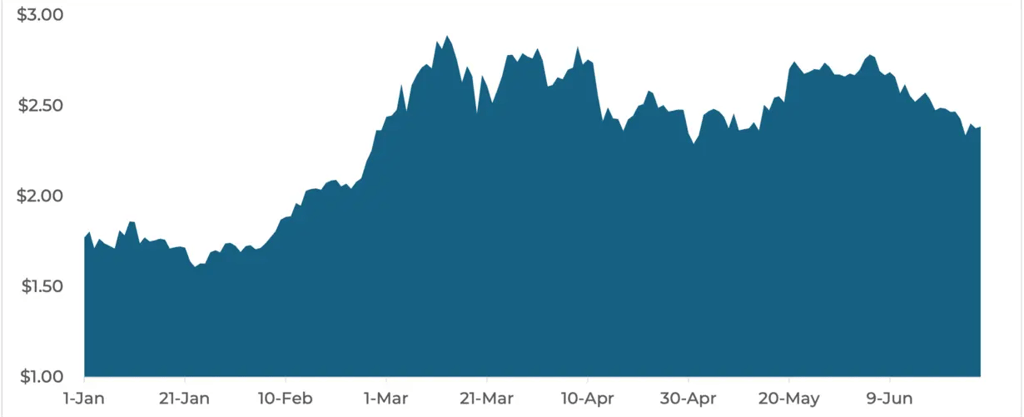

(Source: The Block)
Sector Snapshot
Over the past year, the cryptocurrency market has seen diverse sector performance. The AI sector leads with an impressive 414.7% increase, highlighting the growing importance of AI-related cryptocurrencies. Following this, RWA (Real World Assets) and DePIN (Decentralized Physical Infrastructure Networks) have surged by 215.3% and 260.9%, respectively, showing strong interest in bridging digital and physical assets and decentralized infrastructure. Centralized exchanges and DeFi rose by 106.2% and 68.6%, respectively, indicating increased trading activity and interest in decentralized finance.
Bitcoin and Ethereum showed strong performance, up 130.4% and 97.9%, respectively. Conversely, NFT Applications and Social sectors underperformed, with NFT Applications down 28.1% and Social up only 7.2%. Overall, the average sector performance over the year was 110.1%, showcasing a generally bullish trend in the cryptocurrency market.
Figure 3 – Weighted Average Sector Performance
(Source: Artemis)
DeFi
The recent market resurgence has sparked notable advancements in the decentralized finance (DeFi) sector. The broad rally has significantly boosted capital inflows into DeFi, elevating the total value locked (TVL) to an impressive US$101.5 billion, a significant increase from US$53.75 billion at the beginning of the year, marking a robust 84% year-to-date surge.
However, while DeFi has successfully attracted substantial on-chain liquidity, its market cap growth has not kept pace with the overall crypto market. This is evident in the DeFi Dominance metric which stands currently at 3.7%, this shows that DeFi’s market cap as a percentage of the global crypto market cap remains relatively unchanged. This indicates that despite DeFi’s growing liquidity, its public market valuations are yet to align with the broader market trends.
Figure 4 – Total Value Locked (TVL) in DeFi
(Source: DefiLlama)
The Yield Market
The yield market has emerged as a pivotal DeFi sub-sector this year, experiencing a remarkable 184% growth to reach US$10.64 billion in total value locked (TVL). This surge marks a significant breakthrough for a sector that has historically been underdeveloped and underexplored in decentralized finance.
The rise of yield-bearing assets and their inherent volatility has fueled the development of yield markets, creating synergies as more sophisticated products and strategies emerge. This trend is amplified by the tokenization of real-world assets and the advent of liquid restaking, which provide new sources of on-chain yield. Additionally, the shift towards higher yields in lending protocols and stablecoin providers has generated increased interest in on-chain yield trading, further expanding the market.
Figure 5 – Yield is 8th largest DeFi market by TVL
(Source: DefiLlama)
Blue Rabbit Learn
Understanding the DePIN Narrative:
A New Era of Decentralized Infrastructure
Over the past year, the DePIN (Decentralized Physical Infrastructure Networks) narrative has emerged as one of the most significant trends in the crypto industry, second only to AI in terms of market cap growth.DePIN overall is up 260% in market cap, with a 30-day annualized volatility of 73%, DePIN has captured the attention of investors and innovators alike. This trend underscores DePIN's potential to revolutionize and democratize physical infrastructure management.
Sophisticated investors are increasingly seeking diversified exposure to DePIN projects, while innovators continue to develop new solutions, leveraging blockchain for fast, transparent coordination of buy-sell smart contracts. New DePIN tokens are launched weekly, presenting numerous growth and investment opportunities in decentralized infrastructure.
At Blue Rabbit, we take pride in being at the forefront of research into such groundbreaking narratives. In this article, we delve into the DePIN narrative, exploring its mechanisms, benefits, and potential use cases in the crypto industry.
What is DePIN?
DePIN leverages blockchain technology to create decentralized networks where individuals can contribute physical resources such as transport, energy, and wireless connectivity. By integrating these resources with blockchain, DePIN ensures transparent, efficient, and equitable management and remuneration of services. Projects like IoTeX, Helium, Hivemapper, and Natix Network are at the forefront of this revolution, developing blockchain-based management systems for real-world facilities. Let’s try to understand with the help of a short case study on Helium:
Case Study: Helium Network
Helium is a prominent example of a DePIN project. It connects owners of wireless hotspots with a global market of users needing internet connectivity. Helium uses blockchain to seamlessly and transparently link buyers and sellers in the wireless network market, raising operating funds through a token offering.
Launch and Growth: Helium launched in July 2019. Early buyers of Helium tokens were essentially purchasing pre-IPO shares in a decentralized version of Airbnb for wireless networks. Since then, Helium tokens have risen by over 500%.
Market Impact: Helium now supports over 25,000 active hotspots globally, creating a decentralized and user-driven wireless network.
Innovative Approach: By leveraging blockchain, Helium ensures efficient, secure, and transparent transactions between hotspot owners and users. This decentralized model reduces operational costs and provides fair pricing for connectivity services.
Key Components of DePIN
Blockchain Technology: Serves as the backbone, providing a transparent ledger for tracking ownership, usage, and rewards.
Smart Contracts: Automate and enforce agreements, ensuring that participants are compensated according to predefined rules without intermediaries.
Tokenization: Physical infrastructure assets are represented as digital tokens, which can be traded or used for governance within the network.
Categories of DePIN
DePINs are broadly classified into Physical Resource Networks (PRNs) and Digital Resource Networks (DRNs):
PRNs: Location-based networks where providers contribute hardware resources related to connectivity, mobility, energy, and other sectors. Examples include decentralized wireless networks and energy grids.
DRNs: Networks of fungible digital resource providers, contributing computing power, bandwidth, or storage facilities. These resources are not location-specific and can be utilized from anywhere.
How DePIN Works
DePIN operates by connecting physical facilities to blockchain networks through a middleware that gathers data from these facilities and relays it to the blockchain. This system has three main components:
Physical Infrastructure: Providers contribute physical resources like sensors, internet routers, or solar panels.
Connects physical facilities to the blockchain, collecting and transmitting data.
Blockchain System: Manages data, administers the network, and handles remittance, ensuring providers are rewarded for their contributions.
The DePIN Flywheel
The DePIN flywheel concept revolves around incentivizing providers to commit their resources to the network, which attracts more users due to cheaper service charges. This increased participation boosts the value of the network’s native token, creating a cycle of growth and attracting more providers and investors.
(Source: https://twitter.com/dr_andrewlaw/status/1649067731268894720/photo/1)
Benefits of DePIN
Horizontal Scalability: Allows networks to grow by increasing resources, rather than the capacity of each resource, ensuring flexibility and efficient scaling.
Community Control: Decentralizes control, like an industrial DAO, where all participants contribute resources and have relative control.
Fair Pricing: Offers cost-efficient operations and fair pricing models, avoiding the price bloating seen in centralized systems.
Cost-efficient Operation: Minimal operational costs for the network, with providers able to use their facilities flexibly across multiple networks.
Permissionless: Open participation for anyone with the required infrastructure, ensuring broad access and inclusivity.
Incentivization: Providers earn passive or active income, utilizing otherwise dormant resources.
Use Case Examples
Decentralized Wireless Networks: Community-operated networks where individuals install Wi-Fi hotspots, contributing to a decentralized network and earning rewards based on usage.
Decentralized Energy Grids: Homeowners with solar panels sell excess energy to their neighbors, with transactions recorded on the blockchain and rewards distributed via smart contracts.
Sensor Networks for Smart Cities: Individuals or businesses deploy sensors that collect data on air quality, traffic, and weather, earning tokens for their contributions.
Challenges
Despite its promise, DePIN faces several challenges:
Adoption Stage: Attracting enough providers and users to power the network and achieve the desired flywheel effect.
Technological Complications: Educating potential participants about the technical aspects of DePIN.
Cost of Running Private Facilities: The operational costs of some facilities may be high, posing a challenge for providers.
Profitability: Ensuring the network can remit attractive rewards to providers, maintaining their interest and participation.
Conclusion
DePIN represents a groundbreaking approach to managing physical infrastructure, democratizing control, and incentivizing participation through blockchain technology. By addressing current limitations and leveraging the collective power of decentralized networks, DePIN has the potential to transform various sectors, from telecommunications to energy, making them more resilient, efficient, and inclusive. As the technology matures and adoption grows, DePIN could become a cornerstone of the future decentralized economy, blending the digital and physical worlds in unprecedented ways.
Charts for your thoughts
In 2024, Bitcoin reached an all-time high with a volatility rate of 40%. This is significantly lower compared to 2021, when volatility soared to over 106% during its record-breaking highs.
Is it the new normal for BTC price action to be boring? Or BTC has reached to new level of maturity and becoming mainstream asset?
How should sophisticated investors build exposure to alt-coins, including AI, DePIN and other emerging token projects? Through fundamental analysis to buy-hold, technical analysis to identify buying/selling opportunities, or in smart index?
Figure 6 – BTC 60 days historical volatility
(Source: Glassnode, Cryptoslate)
References
https://tokenterminal.com/terminal
More info: clientservice@bluerabbit.ai
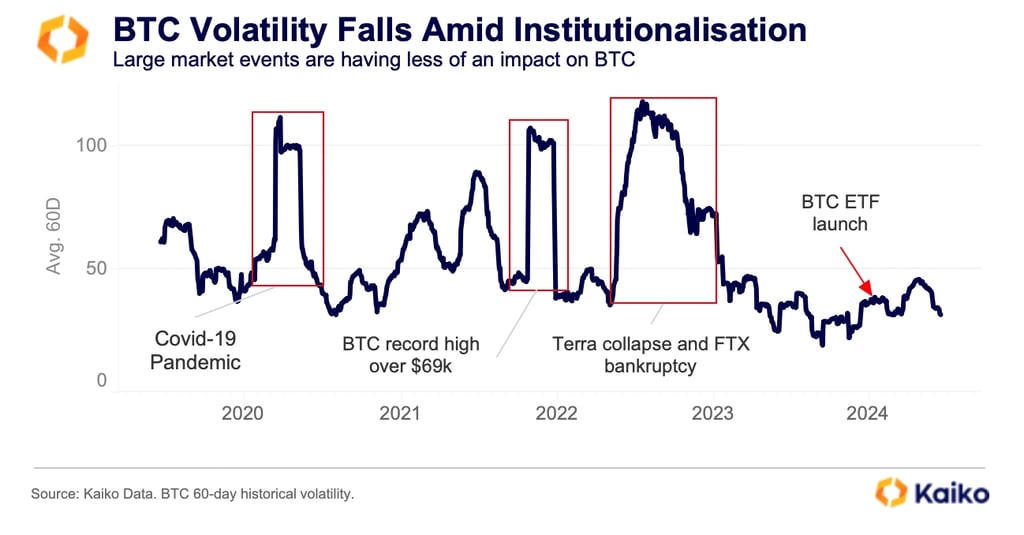

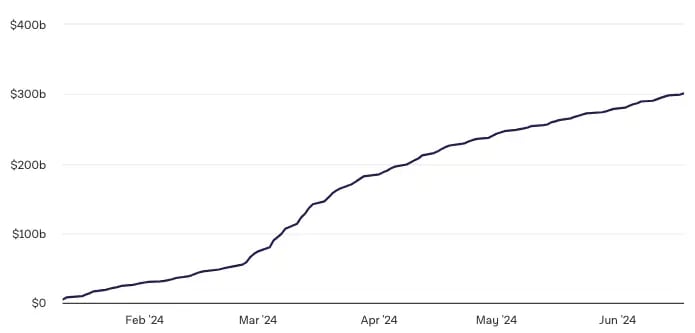

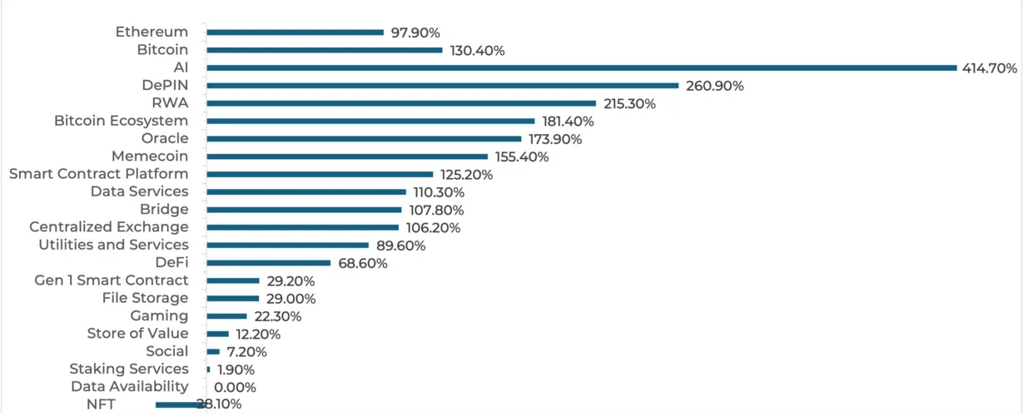

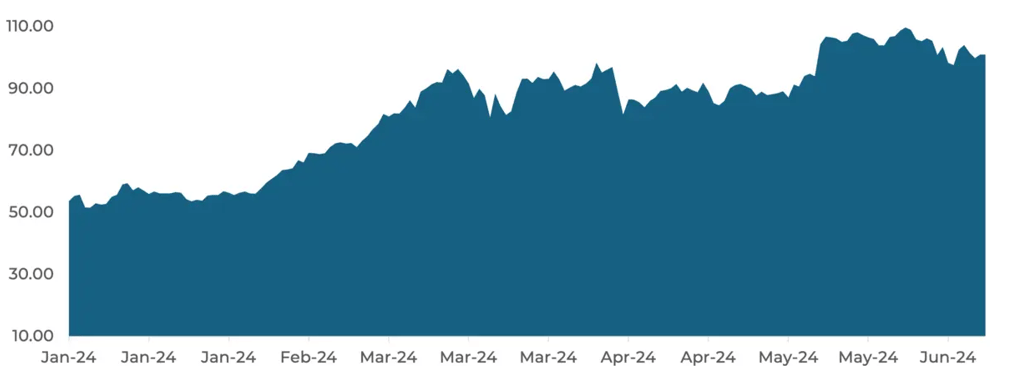

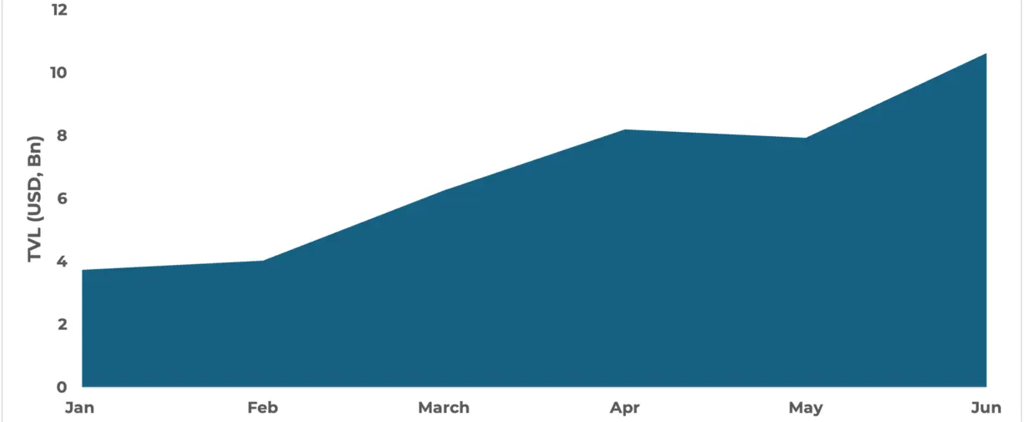

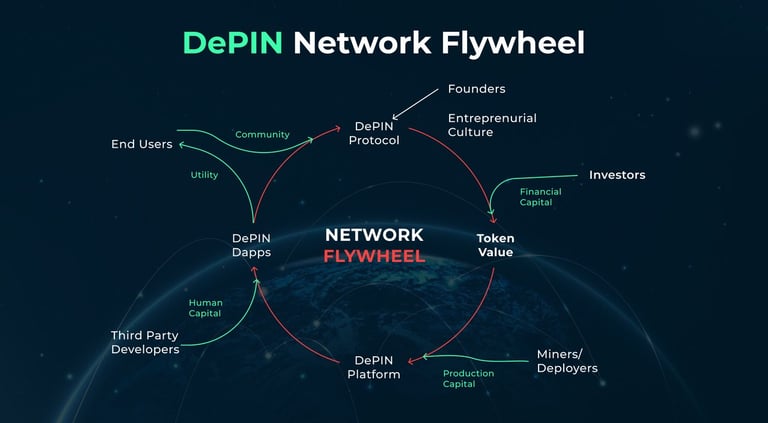

(Source: Kaiko Data)
The trend indicates strong market confidence, as long-term holders typically maintain their positions despite short-term market fluctuations. This contrasts with the behavior of short-term holders, who actively transfer profits to exchanges, especially during periods of market surges.
Do you think BTC will maintain its steady accumulation? Is there a possibility of profit taking by long-term holders in near future especially above USD 70,000?
Figure 7 – BTC total supply in profit held by long-term holders
